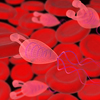by: Levi Beckerson
Scientists fish for tumors with nanoworms.

Another nanoscale anti-cancer device has arrived on the growing scene. Similar to MIT's sticky nanoparticles, the new treatment would involve a sticky "nanoworm." The particles, developed jointly by scientists at the Universities of California at San Diego and Santa Barbara along with MIT, resembles a gummi worm made of small spheres.
The worms are made from spherical nanoparticles of iron oxide, joined together and coated with a polymer derived from dextran. Each worm consists of eight nanoparticles and measures approximately 30 nanometers in length. That makes them about three million times smaller than their earthworm brethren.
There are multiple advantages in using the new nanoworms over single particle approaches for locating and delivering cancer destroying drugs directly to tumors. The structure allows the worms to slip through the bloodstream with less opposition than single particles, which are more easily detected and driven out by the body's immune system functions. This keeps them in the body longer, giving them more time to find targets.
Another advantage is the amount of anti-cancer toxins a single worm can carry versus a single particle. Obviously by having more surface area, more toxins could be attached, thus serving target tumors a more lethal dose. Not only could more drug be attached, but more of the peptide which causes the particles to stick to the tumors, called F3, can share the surface, making them more likely to lock on when a tumor is located.
Yet another is that the worms' construction material, iron oxide, has the quality of being superparamagnetic, which causes them to light up an MRI scan in areas of suspicion. Even if only one of the worms finds a certain target, it is more easily detected than single superparamagnetic particles, like MIT's, because of its size.
While the results of the group's work are impressive, they are still researching different ways to attach anti-cancer drugs to the nanoworms, as well creating special chemicals that will allow administers to target specific types of tumors. Once a tethering method is found, it could allow the worms to be even more lethal to cancer cells than MIT's nanoparticle or Rensselaer Polytechnic's nanotube methods.
